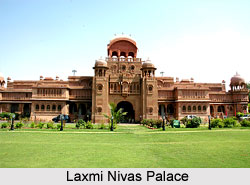 Laxmi Niwas Palace, located in Bikaner in Rajasthan, was a residential palace of Maharaja Ganga Singhji. The regency council in the last year of its regime in 1897 AD took the responsibly of constructing this palace. The palace was planned and designed by the British architect, Sir Samuel Swinton Jacob. He was the then Chief Engineer of Jaipur State. The palace has been built in Indo-Saracenic style and it took almost a period of four years to complete. Laxmi Niwas Palace has been built between 1898 and 1902.
Laxmi Niwas Palace, located in Bikaner in Rajasthan, was a residential palace of Maharaja Ganga Singhji. The regency council in the last year of its regime in 1897 AD took the responsibly of constructing this palace. The palace was planned and designed by the British architect, Sir Samuel Swinton Jacob. He was the then Chief Engineer of Jaipur State. The palace has been built in Indo-Saracenic style and it took almost a period of four years to complete. Laxmi Niwas Palace has been built between 1898 and 1902.
Architecture of Laxmi Niwas Palace
The magnificent palace courtyards made of marble and were adorned with magnificent halls and anterooms also. It has been built of pink sandstone that was brought from the stone quarries of Dulmera, some 45 kms north of Bikaner city. The corridors of the palace had a series of columns arranged at regular intervals and its splendid balconies were mounted with canopies. The intricate filigree and lattice work in stone and wood adorned the balconies and further enhanced its beauty and charm. The interior of Laxmi Niwas Palace have been aesthetically designed with frescoes and mural paintings in gold. They also had exquisite lacquers embellishing the grandeur. These splendid architectural works were executed by the hereditary craftsmen of Bikaner. The overall supervision of the palace was carried out by the Maharaja himself who took a keen interest in the finalisation and execution of the work during the different stages of the construction of the palace.
When the construction of the palace was over it was given the name of goddess of wealth and prosperity i.e. `Laxmi Niwas Palace.` The name and fame of the artistic grandeur of the palace spread far and wide. Influential people from different came to have a look of the splendid palace and experience its magnificence and elegance. Architects like "Lutyens and Baker" in 1914 came here during their tour to India. The palace was exclusively for the use of Royal family and their guests. The Maharaja`s flair for hospitality made him invite many famous people here like George V & Queen Mary, the king of Greece, the Prince of Wales, viceroys, Maharajas and renowned statesmen including his old friend, the great French radical leader M. Clemenceau, Dr Rajendra Prasad, the First president of our republic; founder of the Benaras Hindu University, Pt. Madan Mohan Malviya Ji, Dr Sarojini Naidu, Sir Tej Bahadur Sapru, Sir Akbar Haidri and many others.
Set amidst the natural surroundings and dotted with landscaped gardens with lily pools and fountains the Laxmi Niwas Palace was later luxury hotel owned by Golden Triangle Fort & Palace P. Ltd in the twenty first century. The 42 palatial rooms with all the modern amenities pay as a host to several people.



















